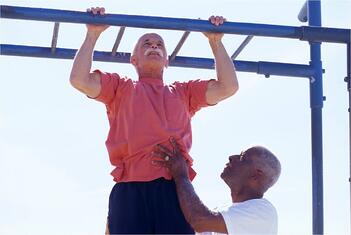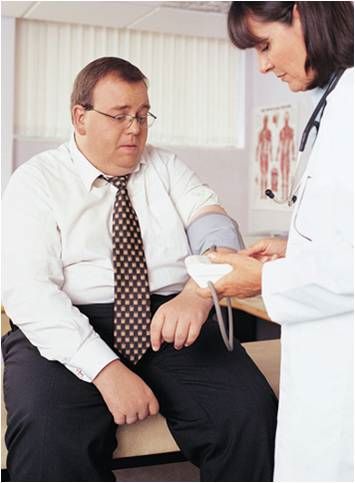 A new year means new trends to follow! What do you have planned for your workout routine this year? Hopefully, the plan is to either begin or continue your fitness routine, but possibly add more variety into it. Make it your year to become familiar with the endless options and try something new!
A new year means new trends to follow! What do you have planned for your workout routine this year? Hopefully, the plan is to either begin or continue your fitness routine, but possibly add more variety into it. Make it your year to become familiar with the endless options and try something new!
The new trends predicted to become popular and make you sweat at the gym this year are:
- Body Weight Training
- High Intensity Interval Training (HIIT)
- Treadmill Training
Wait, body weight training? What happened to lifting heavy? Body weight training is predicted to be the next big thing this year. This includes comprehensive incorporation of gymnastics, adult jungle gyms, uncluttered workout spaces, suspension training options, basic movements, and programming that is not as focused on the standard weight lifting protocols. This means back to the basics with lunges, squats, and push-ups. What are your thoughts? Will the benefits from body weight training be as successful as lifting heavy weights?
HIIT, the alternating bursts of exercises with short recovery periods, is a popular trend known for its quick fat blasting tactics. I mean, who wants to spend endless hours at the gym when you can just knock out about 20-30 minutes of HIIT? Trust me, that is plenty of time to get a ‘sweatastic’ workout in and definitely one my personal favorites. You can create quite the variety of workouts, allowing your muscles to always be surprised by what is next. Plus, the variety can keep it interesting and fun so you don’t get burnt out so easily!
Treadmill training is poised to be the next “it” workout, according to Health Magazine. I know many are not fans of treadmill workouts and are tempted to consider it torture, but Health Magazine names running as the oldest form of exercise. I, myself, would rather run outside than on a treadmill any day. That tends to become a challenge during the colder months, so I put together treadmill interval and speed variation workouts to keep myself from getting bored of my workout. With this up and coming trend, classes will allow participants to improve their running through speed and interval-based training drills. Participants will also have the chance to become more engaged in their workouts and can avoid the worrisome of how to log miles when it is cold or rainy, since training is indoors.
These workouts are meant to push your body’s limits. With the higher chance of being sore, there is a need for recovery - foam rolling, restorative yoga, therapy balls, dynamic stretching, and core strengthening are perfect examples. A good night’s rest is also important for recovery. Allowing for recovery time after an intense workout decreases your chance of overtraining your muscles and the potential for injuries.
So, now that you are familiar with the predicted trends, how will you log your intense workouts? We are in a generation that is highly involved with technology - fitness watches and Smartphone apps at our fingertips. Digital engagement keeps us motivated, gives us inspiration, and coaches us through our workouts. Do you have a favorite piece of technology you use to track your workouts?
Overall, what do you think about these trends? Are you interested in trying out something new this year?! Connect with a health fitness specialist in your corporate fitness center or local gym to get started on a better you.
Subscribe to our blog and recieve our Free Workout Friday blogs directly to your inbox!


 So what does this have to do with anything health and wellness related, you ask? Well, there have been numerous observances and studies focusing on how a positive or negative attitude affects a person’s health and recovery.
So what does this have to do with anything health and wellness related, you ask? Well, there have been numerous observances and studies focusing on how a positive or negative attitude affects a person’s health and recovery. 
 Every morning I am hitting up the NIFS Fitness Center working towards the goal to stay healthy and fit. I see all types of people with different fitness interests; those who participate in group fitness classes, those who always do cardio, or those who strictly lift weights. No matter their interest, I am always curious about their fitness journey. Why did they start? What is their progress? Are they working towards a goal? My usual gym routine consists of mostly lifting weights and getting in some cardio as well. I try to keep it balanced, but it is occasionally difficult. Being female and lifting heavy weights just seems to be so wrong and unattractive to some these days, but why? Wouldn’t you think that
Every morning I am hitting up the NIFS Fitness Center working towards the goal to stay healthy and fit. I see all types of people with different fitness interests; those who participate in group fitness classes, those who always do cardio, or those who strictly lift weights. No matter their interest, I am always curious about their fitness journey. Why did they start? What is their progress? Are they working towards a goal? My usual gym routine consists of mostly lifting weights and getting in some cardio as well. I try to keep it balanced, but it is occasionally difficult. Being female and lifting heavy weights just seems to be so wrong and unattractive to some these days, but why? Wouldn’t you think that  We see
We see  Feeling drowsy throughout your day? Always need that cup of coffee first thing in the morning and possibly in the afternoon? Well, you’re not alone. Getting enough sleep every day is essential for proper functioning and well-being, but many people do not get the recommended amount of sleep that they should per night. The average adult should sleep
Feeling drowsy throughout your day? Always need that cup of coffee first thing in the morning and possibly in the afternoon? Well, you’re not alone. Getting enough sleep every day is essential for proper functioning and well-being, but many people do not get the recommended amount of sleep that they should per night. The average adult should sleep  Have you fallen off track from your New Year’s resolutions and need a kick start back in the right direction? Since it's National Nutrition Month® it is the perfect time to regain focus on healthy eating behaviors! Getting back into a healthy routine does not mean seeking out the next fad diet, but learning to enjoy healthy and nutritious food. The
Have you fallen off track from your New Year’s resolutions and need a kick start back in the right direction? Since it's National Nutrition Month® it is the perfect time to regain focus on healthy eating behaviors! Getting back into a healthy routine does not mean seeking out the next fad diet, but learning to enjoy healthy and nutritious food. The  Are you looking for fitness tips, a little extra motivation or some exercise accountability? There’s an app for that! Over the past few years, health and fitness apps have grown and can provide information such as, distance and pace, strength, circuit and flexibility routines, estimate calorie expenditure, and some can measure your heart rate. Some apps will send daily fitness tips or motivational statements to help keep you on track with your exercise routine. But, if you’ve ever tried to search for health and fitness apps on your phone, you know how overwhelming it can be.
Are you looking for fitness tips, a little extra motivation or some exercise accountability? There’s an app for that! Over the past few years, health and fitness apps have grown and can provide information such as, distance and pace, strength, circuit and flexibility routines, estimate calorie expenditure, and some can measure your heart rate. Some apps will send daily fitness tips or motivational statements to help keep you on track with your exercise routine. But, if you’ve ever tried to search for health and fitness apps on your phone, you know how overwhelming it can be. Honestly, our staff run into this all the time. Anyone who has ever managed a fitness program with a policy in place that requires a medical release for individuals with specific health risks before they can participate knows how many would-be exercisers get disgusted with that policy and thus never return to join your program. I get it, it’s frustrating.
Honestly, our staff run into this all the time. Anyone who has ever managed a fitness program with a policy in place that requires a medical release for individuals with specific health risks before they can participate knows how many would-be exercisers get disgusted with that policy and thus never return to join your program. I get it, it’s frustrating. 

 Generally speaking, there are 3 “sections” to each fitness center. On one side, you have the cardio area. On the other side is the resistance area. And somewhere in the corporate fitness center is usually a group exercise room. The latter can be used for just about anything so we’ll leave that alone for the time being. That leaves us with the cardio and resistance areas.
Generally speaking, there are 3 “sections” to each fitness center. On one side, you have the cardio area. On the other side is the resistance area. And somewhere in the corporate fitness center is usually a group exercise room. The latter can be used for just about anything so we’ll leave that alone for the time being. That leaves us with the cardio and resistance areas.